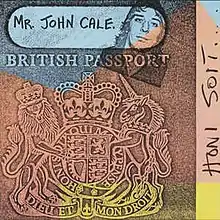Honi Soit (album)
Honi Soit is the seventh solo studio album by Welsh musician John Cale, released in March 1981 by A&M Records, and was his first studio album in six years following 1975's Helen of Troy. It was recorded and mixed by Harvey Goldberg at CBS Studios, East 30th Street and Mediasound in New York City with the intention of making a more commercial album with producer Mike Thorne at the helm, Thorne would soon be known for his work with Soft Cell. "Dead or Alive" was the only single released from the album but it did not chart. However, Honi Soit is Cale's only album to date to chart on the US Billboard 200 to date, peaking at No. 154.[1]
| Honi Soit | ||||
|---|---|---|---|---|
 | ||||
| Studio album by | ||||
| Released | March 1981 | |||
| Recorded | 1980 | |||
| Studio | CBS Studios, East 30th Street and Mediasound, New York City | |||
| Genre | Art rock | |||
| Length | 37:45 | |||
| Label | A&M | |||
| Producer | Mike Thorne | |||
| John Cale chronology | ||||
| ||||
| Singles from Honi Soit | ||||
| ||||
In 1991, Universal re-released the album on CD. It only held the songs from the original LP. This same version of the album has been reissued twice: in 2004 and 2018.
Content
All of the tracks on Honi Soit were written by John Cale, except for "Streets of Laredo", a traditional song arranged by Cale about a dying cowboy telling his story to another cowboy. The track "Need Your Loving" was left off the album in favour of "Riverbank".[2]
American artist Andy Warhol suggested that the album should be called John and Yoko,[3] and provided the cover art, in black and white, but against Warhol's wishes Cale colorized it,[3] a decision recounted by Cale on the song "A Dream" from his 1990 collaboration album with Lou Reed about Warhol, Songs for Drella. In a tongue-in-cheek allusion to the song "Fighter Pilot", the credits on the sleeve give each of the musicians a mock military aviation role, with Cale described as "flight surgeon". The album's title is an abbreviation of the phrase "Honi soit qui mal y pense" (French: "shame upon him who thinks evil of it"[4]), the motto of the British chivalric Order of the Garter.[5]
Critical reception
| Review scores | |
|---|---|
| Source | Rating |
| AllMusic | |
| Trouser Press | (mixed)[7] |
| The New York Times | (positive)[8] |
Robert A. Hull of Creem wrote that "Once again on Honi Soit – from the opening trumpet blast of "Dead or Alive" to the final pounding of the drums on "Magic & Lies" – Cale evokes the epochal – this time as a series of battles, as a pure declaration of war. Like Lou Reed's Street Hassle, it's a work on which the artist finally reveals himself, concealing his tracks yet at the same time blowing his cover."[9] Stephen Holden of the New York Times called the album "excellent", and described Cale as "one of the godfathers of new-wave music, [who] has accomplished the seemingly impossible feat of reconciling the ferocity of postpunk rock with the stateliness of European classicism."[8]
In a retrospective review for AllMusic, critic Mark Deming said that "Honi Soit rivals Fear as the most lividly uncomfortable album in Cale's catalog, and that's saying something."[6]
Track listing
All tracks are written by John Cale, except where noted.
| No. | Title | Writer(s) | Length |
|---|---|---|---|
| 1. | "Dead or Alive" | 3:51 | |
| 2. | "Strange Times in Casablanca" | 4:13 | |
| 3. | "Fighter Pilot" | 3:10 | |
| 4. | "Wilson Joliet" | 4:23 | |
| 5. | "Streets of Laredo" | Traditional; arranged by John Cale | 3:34 |
| No. | Title | Length |
|---|---|---|
| 6. | "Honi Soit (La Première Leçon de Français)" | 3:20 |
| 7. | "Riverbank" | 6:26 |
| 8. | "Russian Roulette" | 5:15 |
| 9. | "Magic & Lies" | 3:26 |
| Total length: | 37:45 | |
Personnel
Credits are adapted from the Honi Soit liner notes.[10]
- John Cale ("flight surgeon") – lead vocals; guitar; keyboards; viola
- Jim Goodwin ("gunner") – keyboards; synthesizer; backing vocals
- Sturgis Nikides ("hellcat") – guitar; backing vocals
- Robert Medici ("navigator") – drums; backing vocals
- Peter Muny ("wing and prop") – bass guitar; backing vocals
- John Gatchell – trumpet
- Bomberettes (members of Mo-dettes) – backing vocals on "Fighter Pilot"
Production
- Mike Thorne – producer ("computer processing")
- Harvey Goldberg – recording; mixing
- Carl Beatty – engineer
- Harold Tarowsky – assistant engineer
- Jane Friedman – management ("propaganda")
- John Vogel – graphic design
- Andy Warhol – cover concept
- Fred Lorey – photography
- Warren Frank – "flight engineer"
- Louis Tropia – "logistics"
References
- "TOP LPs & TAPE". Billboard. 93 (16): 77. April 25, 1981 – via Billboard (Archive: 1963-2000).
- https://werksman.home.xs4all.nl/cale/disc/honi_soit.html
- Cale, John; Bockris, Victor (1999). What's Welsh for Zen. London: Bloomsbury. p. 196. ISBN 0-7475-3668-6.
- nb : The spelling of the word "Honi" is old French, it would nowadays be spelt "Honni".
- Cale, John; Bockris, Victor (1999). What's Welsh for Zen. London: Bloomsbury. p. 197. ISBN 0-7475-3668-6.
- Deming, Mark. "Honi Soit – John Cale". AllMusic. Retrieved 13 May 2020.
- Grant, Steven; Sheridan, David; Robbins, Ira. "TrouserPress.com :: John Cale". TrouserPress.com. Retrieved July 5, 2016.
- Holden, Stephen. "Post Punk Art of John Cale". the New York Times. Retrieved 13 May 2020.
- Robert A. Hull. "John Cale: Honi Soit". Rock's Backpages.
- Honi Soit liner notes. A&M Records. 1981.
External links
- Honi Soit at Discogs (list of releases)
- Interview with Mike Thorn, producer of Honi Soit